Japan Wood Products
Prices
Dollar Exchange Rates of
26th May2014
Japan Yen 101.90
Reports From Japan
Machinery orders surge ahead
Japan‟s Cabinet Office has released details of its latest
business survey. This shows that the total value of
machinery orders received by 280 manufacturers operating
in Japan increased by 4.0% in March from the previous
month. In the period January-March machinery orders rose
by 4.3% compared with the previous quarter.
Private-sector machinery orders ( excluding volatile ones
for ships and those from electric power companies)
increased a seasonally adjusted by 19.1% in March, and
showed an increase of 4.2% in the first quarter signalling
that private investment may support the economy as
consumers cut back on spending to adjust to the new
consumption tax rate.
For the full details see:
http://www.esri.cao.go.jp/en/stat/juchu/juchu-e.html
Releasing private sector capital investment is a major
target of the Japanese government as this is seen as
providing a pillar upon which the economy can grow. The
latest data on machinery orders has boosted the confidence
of government analysts who say they foresee good
prospects for economic expansion during the next 2 to 3
months.
Fifth straight drop in consumer confidence index
Japan‟s Cabinet Office has released the results of the latest
Consumer Confidence Survey conducted 15 April 2014.
The Consumer Confidence Index fell 0.5 points to a
seasonally adjusted 37.0 in April, the fifth straight
monthly decline but the pace of decline in April was the
slowest recorded during the current downtrend.
However, the index remains at its lowest point for the past
two years when the index dropped to a low of 36.9 in
August, 2011.
Most of those surveyed were pessimistic on three of the
four sub-indexes in the survey ( economic well-being,
income growth and job prospects), but the sub-index on
the willingness to purchase durable goods rose after four
months of decline.
See: http://www.esri.cao.go.jp/en/stat/shouhi/shouhie.
html
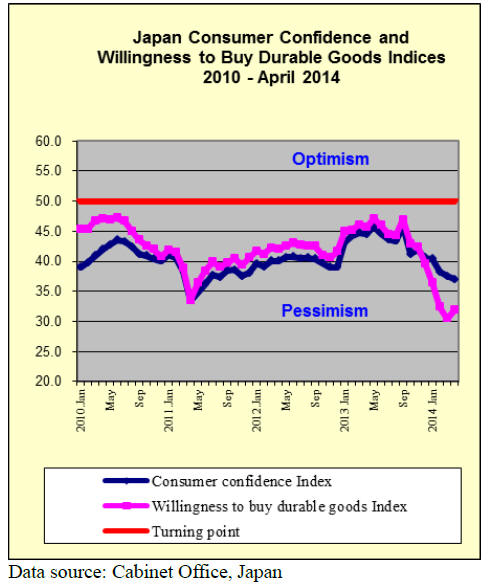
Retail sales down but by less than expected
Data from Japan‟s Ministry of Economy, Trade and
Industry (METI) shows that retail sales for April were
down 4.4% from the same period last year and down
almost 14% from March this year, a rather modest fall
given the boom in consumer spending prior to the 1 April
increase in sale tax.
The numbers show that the declines were spread across
most products but were steepest for the more expensive
consumer durables such as cars, televisions, refrigerators
and air-conditioners.
For the full details see:
http://www.meti.go.jp/english/statistics/tyo/syoudou/
First quarter GDP ‘shock’
Japan‟s first quarter GDP was up 1.5 percent from the last
quarter of 2013. This figure is way beyond analysts‟
expectations and reflects the surge in consumer spending
prior to the increase in consumption tax.
Personal consumption was so high in the first quarter that
any impact from the slowing of the US was overwhelmed.
Private consumption in the first quarter was up an
annualised 8.5%!
The boost to GDP growth defies the overall sluggish
economic performance and is a one-off surge unlikely to
be repeated in the quarters to come. Second quarter figures
due in July are expected to be very sobering.
Analysts are forecasting a correction in monthly GDP
growth which hit a record high of 5.9% on an annualized
basis in March.
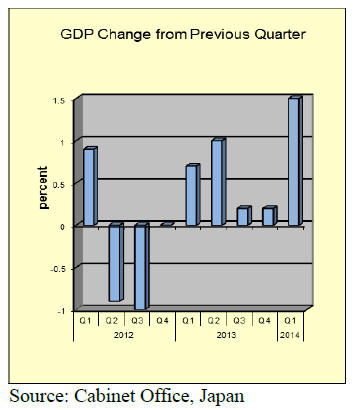
April housing starts better than expected
April housing starts were up on levels in March, a
particularly poor month but, at 75,300, were some 4%
down on April 2013.
However, the April figures were much better than
expected as analysts had forecast starts to fall as much as
8% year on year.
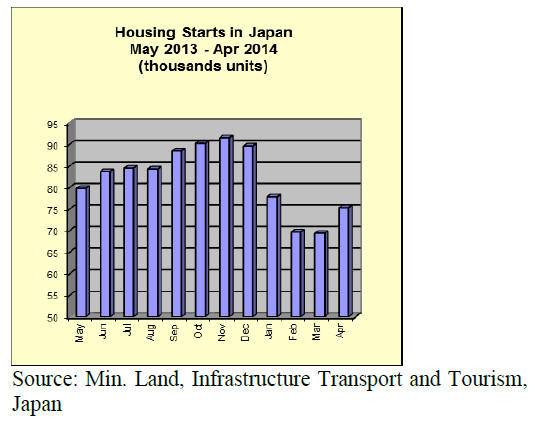
BoJ sticks to weak yen policy
The Japanese yen strengthened against the dollar in the
latter half of May with the US dollar trading at only 101.5
at its lowest point.
The yen may have derived some of its strength as money
moved out of dollars after the US stocks have tended
towards weakness. Even at yen 101.5 to the dollar the yen
is down about 16 percent against the dollar year-on-year.
The Bank of Japan (BoJ) governor has warned that that a
sustained rise in the value of the yen would undermine the
targets set by the Bank clearly signalling that it will act to
stem any major rise in the yen.
The BoJ has is sticking firmly to its 2% inflation goal and
appears determined to provide substantial monetary
stimulus to achieve its goal.
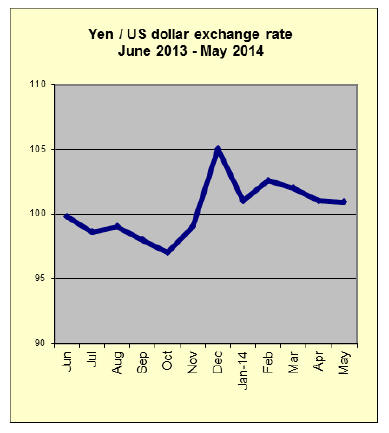
Plywood mills easing back on production
Shipment of softwood plywood from domestic mills for
large house builders and pre-cutting plants continue firm
even after consumption tax increase since April but the
orders in wholesale channel are declining.
March softwood production was 226,800 cbms, 5.4%
more than February and the shipment was 222,300 cbms,
0.7% more and the inventory was 92,000 cbms.
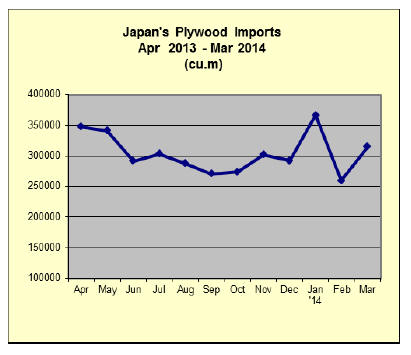
Movement in wholesale channel remains stagnant in April
and the prices are weakly holding at 1,010 yen per sheet
on 12 mm 3x6 delivered (special type/F☆☆☆☆). Thick
24 mm panel prices are unchanged at 2,050 yen. 9mm
3x10 long panel prices are 1,450 yen.
Plywood mills say that movement of plywood had been
120-130% of production capacity before the tax increase
then things go back to normal and drop of demand is
within initially forecasted. With very limited inventory,
mills are not worried about so much about future market.
Log production in Sarawak, Malaysia continues low with
continuous dry weather so that log market prices stay up
high and plywood mills struggle to procure logs even with
high prices.
Plywood mills have to ask high export prices because of
high log cost. In Indonesia, argument on timberharvest tax
increase continues and log suppliers and plywood mills
have already asked higher prices.
In Japan, supply and demand are balancing on 3x6 coated
concrete forming panel with the supply beingtight because
of delayed shipment. JAS concrete forming 3x6 panel
prices are 1,250 yen per sheet delivered.
JAS coated concrete forming panel prices are 1,350 yen.
Both are unchanged from April. 12 mm structural panel is
about 1,300 yen, which is the only weak item.
Indonesian timber harvest tax to impact prices
Indonesia changed ordinance on timber harvest tax in
February, which is in force since March 14. However,
there has been continuous argument on this issue between
the government and the industry and this has not been
actually applied yet.
Once this is applied, it will be sizable increase of tax,
Ordinance is effective next to law in Indonesia and the
ordinance was signed by the President and the Minister.
Focus of this is higher tax on logs produced by clear
cutting for the purposes of replanting, mining and
agricultural development. Tax on meranti will be about
600,000 rupiah (about $60) per cbm and about 360,000
rupiah (about $36) on MLH.
So far tax of 60,000 rupiah is imposed on all the species of
IPK logs (wood utilization permit logs) then non tax on
HTI logs (industrial plantation logs). Generally IPK is
timber harvest for purpose of changing property to oil
palm or mining and HTI is logs from clear cut with the
purpose of replantation.
In any case, prices of MLH logs with less than 30 cm in
diameter, which had been traded with $70-80 per cbm,
would go up to $110-140 so they would be as high as
MLH logs in Sarawak, Malaysia ($120-130).
Now the tax is collected by each provincial government
and each province has different tax system and the
provincial governments are busy coordinating with the
local industry so it is not actually in effect yet.
Announcement of the change came all of a sudden so there
are various conjectures as to why this came up now but
tendency in Indonesia is that the government has been
trying to increase tax for every sector of industry.
One view is there are increasing number of changing of
plantation to oil palm plantation without any permit so that
palm oil market prices are declining by oversupply and the
government is trying to control and manage such transfer
business.
Log demand statistics for 2013
The Ministry of Agriculture, Forestry and Fisheries
disclosed the statistics of log demand in 2013. Total log
demand was 26,029,000 cbms, 5.6% more than 2012.
With active housing starts, log demand for lumber and
plywood increased by 6.3% and 9.0% respectively.
Demand for domestic logs increased by 6.3% while that
for imports increased by 3.3% so share of domestic logs
increased to 75.9% (74.9% in 2012). Log demand had
increased for four consecutive years. Compared to the
recent low of 2009, 2013 was 14.1% more, out of which
domestic log demand increased by 18.2%.
Logs for lumber were 17,271 M cbms, out of which
domestic logs were 12,058,000 cbms, 6.5% more than
2012 and imported logs were 5,213,000cbms, 5.8% more.
Share of domestic logs was 69.8%, almost the same as
2012. In imports, South Sea and New Zealand logs
decreased by 7.8% and 17.2% but North American and
Russian logs increased by 11.8% and 4.0%. Logs for
plywood were 4,181,000 cbms.
In this, domestic logs were 3,016,000 cbms, 15.9% more
and this was the first time that the volume exceeded three
million cubic metres.
Imported logs for plywood dropped down to 1,16,000
cbms, 5.7% less than 2012 so that the share of domestic
logs was 72.1% from 67.1% in 2012.North American logs
for plywood increased by 1.9% but South Sea (tropical)
logs decreased by 18.7%.
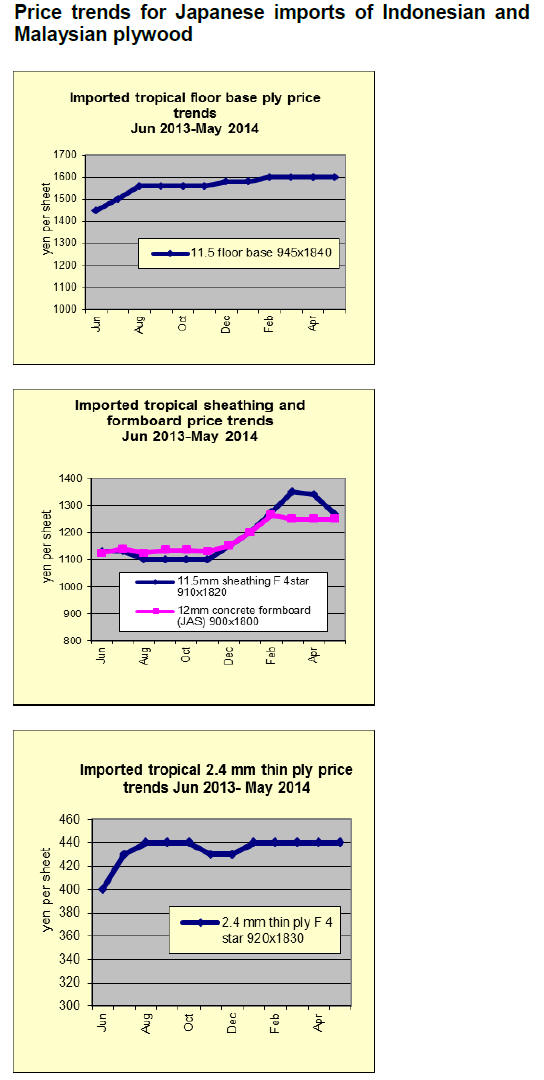
Trends in office, kitchen and bedroom furniture
imports
Japan‟s office, kitchen and bedroom furniture imports
from 2009 to the end of April 2014 are shown below.
Japanese imports of furniture exhibited a cyclical trend
between 2009 and 2012. However, from 2012 bedroom
furniture imports began to increase while imports of office
and kitchen furniture have remained within a narrow
range.
April imports of office, kitchen and bedroom furniture fell
as stocks were readjusted to account for the anticipated fall
in demand in the wake of the consumption tax increase on
1 April.
Consumer purchases of furniture are expected to be slow
in the coming months as consumers adapt household
spending to absorb the impact of the higher consumption
tax.
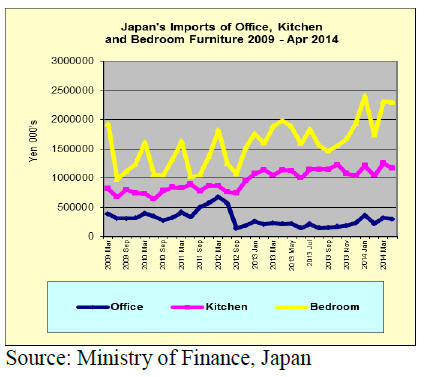
Office furniture imports (HS 9403.30)
April imports of office furniture into Japan fell 6.5%
compared to March. In April, while China was the major
supplier, it saw sales to Japan fall by around 29%.
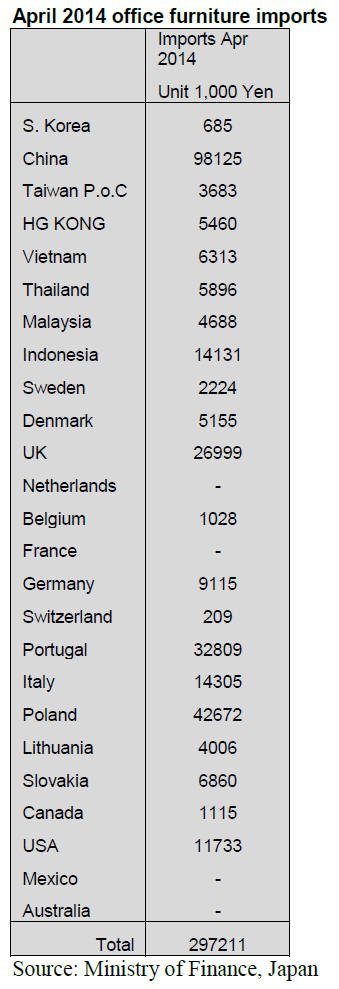
On the other hand, Portugal and the UK saw exports of
office furniture to Japan rise. Japan‟s imports of office
furniture from Portugal accounted for 11% of all imports
of office furniture; double that in March, while imports
from the UK rose from zero in March to account for 9% of
April imports.
The top three SE Asian suppliers in April were Indonesia,
Vietnam and Thailand (approx. 9% of April office
furniture imports).
Kitchen furniture imports (HS 9403.40)
The top three suppliers of kitchen furniture to Japan in
April remained Vietnam, 39.5%, China, 20.1% and
Indonesia 17.8%. Overall, Japan‟s imports of kitchen
furniture fell almost 7% from levels in March. The top
three suppliers accounted for over 75% of April imports of
kitchen furniture.
EU furniture exporters do not have a significant share of
the Japanese kitchen furniture market and in April only
Germany and Italy featured as important suppliers but
together they only accounted for around 2% of all April
kitchen furniture imports by Japan.
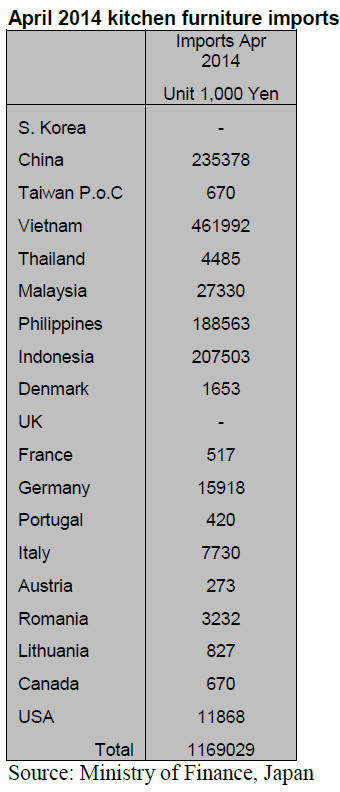
Bedroom furniture imports (HS 9403.50)
After the steep rise in bedroom furniture imports in March
a correction in April would have come as no surprise
however, April imports were largely unchanged and so
avoided the downswing seen with office and kitchen
furniture imports.
The top supplier of bedroom furniture to Japan is China
which accounted for more than half of all bedroom
furniture imports in April. Surprisingly, China‟s April
bedroom furniture exports to Japan rose by around yen 63
million.
The second ranked supplier in April was Vietnam (27%)
followed by Malaysia, a distant 5.6%. Other suppliers in
Asia, the EU and the Americas struggle to secure a market
share with China and Vietnam holding over 80% of the
market for imported bedroom furniture.
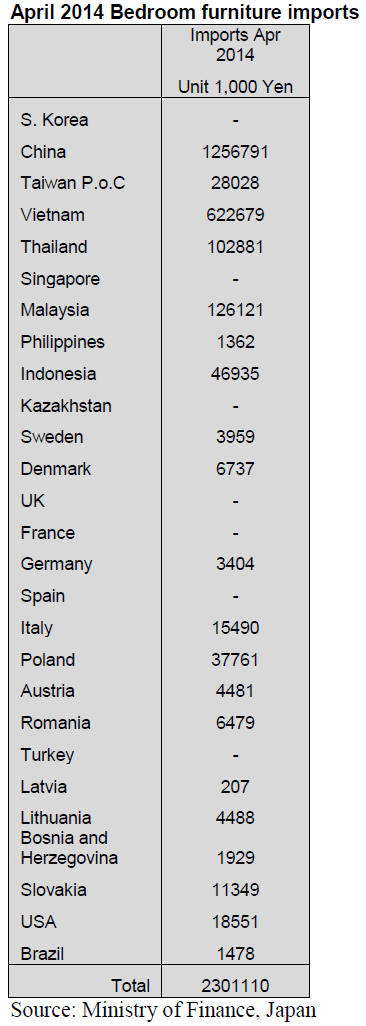
|